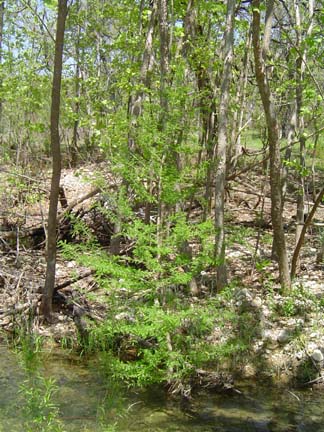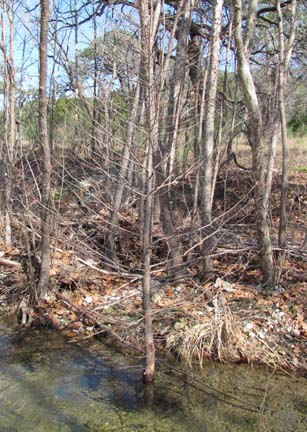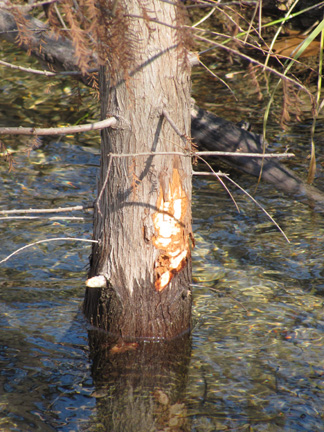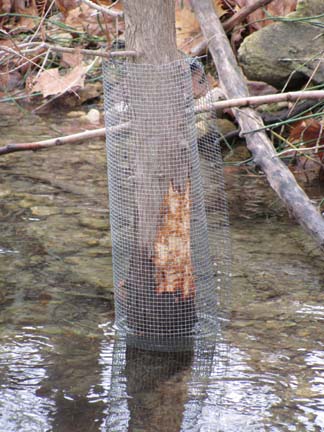
I like trees. I like seedlings, saplings, mature trees, grand stately trees, and malformed little runt trees. I love 'em all. There is something interesting about every tree. One of my favorite old English proverbs is: "
He who plants trees loves others beside himself*." Yet I am fully aware of the dynamics of forests--of birth, growth, and death in the natural world. It's probably good in my business not to get emotionally attached to any one tree (or bush or bird or any one creature). In the course of our very diverse habitat management tasks here at the Refuge, we (collectively) grow and nurture many trees, but we also cut some down, trim some up, and generally watch over the health of our woodland stands. That said, there probably aren't many
individual trees that we would fuss over.
On all 23,000+ acres of this Refuge, we know of just
one naturally occurring Bald Cypress tree (
Taxodium distichum). I believe it was originally discovered by one of our former colleagues, one of the "Oak Wilt Boys", either Bill Reiner Jr. or Eddie Hertz (with apologies if I have misstated that). It was first noted when it was a wee sapling barely 3 or 4 feet tall, on the edge of Post Oak Creek, just about 200 yards from the Refuge HQ. No one takes credit for planting this tree; it probably derives from a seed which floated in on one of the Lake Travis floods of the 1990s which pushed water (and Bald Cypress cones) over FM 1431 and up Post Oak Creek onto what would later become the Refuge's New Salem tract and the Refuge HQ. Over the 6 or 8 years since its discovery, we have watched it grow into a strapping young tree of nearly 15 feet.

 Our lone Bald Cypress tree, on Post Oak Creek, in summer (2007, left) and winter "plumage" (2009, right).
Our lone Bald Cypress tree, on Post Oak Creek, in summer (2007, left) and winter "plumage" (2009, right).
So it was to my great dismay that I noticed last Thursday, Dec. 3, the first gnawings of a beaver around the base of the tree. (Let me quickly add that I like beavers as well. They are an interesting addition to our Hill Country setting. I have never lived or worked in a region such as the Great Lakes or New England where the species can be downright annoying; I have yet to gain that level of antipathy towards this giant rodent, but this particular beaver is testing my patience.) I made a mental note to keep checking on the damage, hoping that over the past weekend, the beaver would either not return or would decide the Bald Cypress tree was not to his/her liking. I was making plans for how I might protect the tree. Monday came around and, with all the email, weeds to pull, moths to photograph, and cold drizzle to avoid (see previous post), I failed to check on the tree.
Today, Tuesday, I was horrified to see that the beaver had been, well, busy...to coin a phrase. The bark had been gnawed off about half way around the tree. I don't think this beaver is trying to fell the tree for a dam or such construction activity; I just get the impression he was hungry for the inner bark as a snack. I'm not a beaver expert; I may be misjudging the evidence**. But that was the last opportunity he/she will have to harm this specimen tree.
I cut a section of 1/4" mesh hardware cloth, gathered some wire cutters, fasteners, and pliers and headed down to the creek. I wrapped a section of the hardware cloth around the trunk, two feet tall above the water and six inches down below the water line, and secured it as best I could with some heavy wire. (Mind you, the tree sits about 2 feet out from the bank of the creek. So, if you will, picture me with my boots off and my pant legs rolled up, dipping my toes in Post Oak Creek on a crisp December morning, to build this tree cage.) Like any nurseryman, I now find myself fretting over this one tree. I'll check it tomorrow and the next day and next week to see if I have deterred the beaver. I must apologize to other trees nearby if the deflected beaver dietary focus is displaced onto them; we all make choices. I can live with this one. Time will tell.

 Before (left, Thursday, Dec. 3) and After (right, Dec. 8).Note the expanded gnawing that happened inbetween those dates.
Before (left, Thursday, Dec. 3) and After (right, Dec. 8).Note the expanded gnawing that happened inbetween those dates.
* * * * *
"Below the Line"
* Chuck's Forestry Rule: No one should be allowed to cut down a tree that is older than himself/herself. This would go a long way towards protecting big trees and old-growth forests. It would also provide an incentive for timber companies to hire at least a few VERY old lumbermen in order to have access to older cohorts of trees to cut. We may assume that, under my rule, any tree over about 100 or 105 years old will have escaped the threat of a chainsaw or dozer.
** Actually, I hope I am not casting blame on the wrong rodent. Some folks have asked me how I would tell the difference between the gnawings of beavers and those of the destructive nutria. We have seen both at various times on the "Turtle Pond" on Post Oak Creek next to the HQ. To my knowledge--and I could be corrected by some mammologist--nutria won't completely gnaw down sapling trees, an outcome we have seen in several instances along Post Oak Creek. Some critter, which I presume to be a beaver, has cut down buttonbush shrubs, willows, and even a few unlucky junipers which happened to be near the creek bank.
Just to cover my, uh, bases, I would like to herewith apologize to all beavers of every stripe if I have maligned this noble species in error. This includes a shout out to all the students, faculty, and staff of Oregon State University, as well as those of Babson College (MA), Bemidji State University (MN--I bet you never thought you'd see them mentioned in this blog!), Bluffton University (OH), Buena Vista University (IA), CalTech (CA), etc., etc., etc., and lest I be inexact, don't forget the "Battlin' Beavers" of Blackburn College (IL) and the Scarlet Knights of Arcadia University (PA), formerly known as Beaver College. Whew! I feel better already.
For a thrill ride through the mascots of this great nation, see College Nicknames on smargon.net.
[The beaver graphic at the top of this blog was ripped from iloveclipart.com.]
